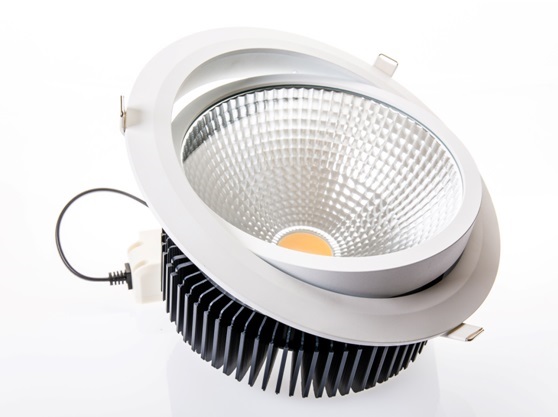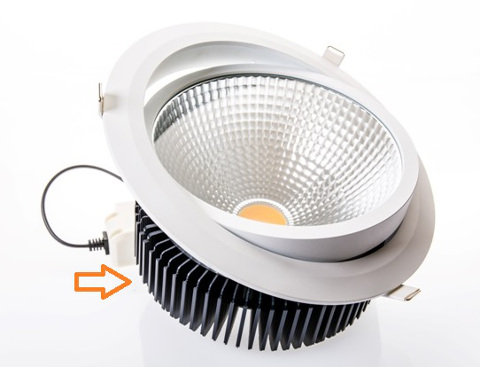[vc_row][vc_column][vc_column_text]
What are LEDs?
[/vc_column_text][/vc_column][/vc_row][vc_row][vc_column width=”2/3″][vc_column_text]A LED (Light Emitting Diode) is a semi conductor light source. When an electronic current is sent through, the LED is activated and emits light. LEDs have been around for more than 40 years. First generation LEDs emitted low intensity infrared light.
In recent years LEDs have undergone important improvements. The ratio power input versus light output has increased, which has made LEDs more efficient. Additional shapes and types of LEDs have become available, which has drastically increased the number of ways in which LEDs can be used. Besides, there are more different light tones available than was the case several years ago.
LED performance is temperature dependent. LED light output rises at lower temperatures, leveling off, depending on type, at around −30 °C.
LEDs are now more widely used in a number of ways compared to several years ago.
In recent years more and more manufacturers have decided to implement LEDs in their products.
The actual LED is placed on a PCB (Printed Circuit Board). A driver is used to provide the actual power needed to activate the LED.[/vc_column_text][/vc_column][vc_column width=”1/3″][vc_images_carousel images=”153,156,154,155″ img_size=”480*320″ onclick=”link_no” autoplay=”yes” hide_prev_next_buttons=”yes” wrap=”yes”][/vc_column][/vc_row][vc_row][vc_column width=”1/3″][vc_single_image image=”65″ img_size=”246×205″ alignment=”right”][/vc_column][vc_column width=”2/3″][vc_column_text]There are different kinds of LEDs. Over the last few years LEDs have undergone tremendous development. For example, the actual light output per LED has increased and there are now many kinds of different LEDs for different applications.
Chip-on-board (COB) LEDs consist of many tiny LEDs that form a larger LED.
The actual LEDs work in conjunction with a PCB (Printed Circuit Board). The LEDs are installed either on the circuit board or the circuit board and LED are integrated (as seen in the picture above showing “individual LEDs”). There are many different kinds of PCBs for use in combination with LEDs available in the market. PCBs can be small and inexpensive but other PCBs for special applications are much larger and extremely costly.[/vc_column_text][/vc_column][/vc_row][vc_row][vc_column][vc_column_text]
LEDs and heat dissipation
The way LEDs are designed results in a need for heat dissipation. If the heat generated by the driver and actual LEDs is properly dissipated (transported to the exterior), the LED benefits. The life span increases and performance of the LED is better. This is why many LED lighting products come with a heat sink.
Some examples of heat sinks:
[/vc_column_text][/vc_column][/vc_row][vc_row][vc_column width=”1/2″][vc_column_text]
Manufacturers of LEDs
There are a number of manufacturers of LEDs. Some of them are companies like Bridgelux, Cree, Epistar and Philips. The characteristics and performance of the LEDs produced by each manufacturer vary.[/vc_column_text][/vc_column][vc_column width=”1/2″][vc_column_text]
Manufacturers of LED lighting products
Nowadays there are literally thousands of manufacturers of LED lighting products. Most manufacturers are based in China and a smaller number is based in Taiwan and in places outside Asia.[/vc_column_text][/vc_column][/vc_row][vc_row][vc_column][vc_column_text]
Quality of components used in LED lighting products
The quality of finished LED lighting products differs per manufacturer. The quality depends on the components used and on the assembly of the components but the knowledge and experience of the manufacturer also plays a key role. Key components from a technical point of few are the LEDs, the PCB and the driver. As is the case in many different industries, if expensive and high quality components are not assembled correctly or treated properly, the final result will be less than satisfying.[/vc_column_text][/vc_column][/vc_row][vc_row full_width=”stretch_row” el_class=”green”][vc_column][vc_column_text css=”.vc_custom_1444444271164{margin-top: 25px !important;margin-bottom: 35px !important;}”]
LED lighting and the advantages of LED lighting for consumers and companies
Note: in the wording shown on this page when talking about LED lighting we are referring to LED lighting products that consist of quality components. LED lighting products that make use of low quality components provide different performance levels and do not offer maximum benefits.
Advantages of LED lighting compared to light sources such as incandescent, fluorescent and energy saving lighting:
- Efficiency: LEDs emit more lumens per watt. The efficiency of LED lighting fixtures is not affected by shape and size, unlike fluorescent light bulbs or tubes.
- Color: LEDs can emit light of an intended color without using any color filters as traditional lighting methods need. This is more efficient and can lower initial costs.
- On/Off time: LEDs light up very quickly. A typical red indicator LED will achieve full brightness in under a microsecond. LEDs used in communications devices can have even faster response times.
- Cycling: LEDs are ideal for uses subject to frequent on-off cycling, unlike fluorescent lamps that fail faster when cycled often, or HID lamps that require a long time before restarting.
- Dimming: LEDs can very easily be dimmed.
- Cool light: In contrast to most light sources, LEDs radiate very little heat in the form of infra red that can cause damage to sensitive objects or fabrics. Wasted energy is dispersed as heat through the base of the LED.
- Size: LEDs can be very small (smaller than 2 mm2) and are easily attached to printed circuit boards.
- Slow failure: LEDs mostly fail by gradually fading over time, rather than the abrupt failure of incandescent bulbs.
- Lifetime: LEDs can have a relatively long useful life. One report estimates 35,000 to 50,000 hours of useful life, though time to complete failure may be longer. Fluorescent tubes typically are rated at about 10,000 to 15,000 hours, depending partly on the conditions of use, and incandescent light bulbs at 1,000 to 2,000 hours.
- Shock resistance: LEDs, being solid-state components, are difficult to damage with external shock, unlike fluorescent and incandescent bulbs, which are fragile.
[/vc_column_text][/vc_column][/vc_row][vc_row][vc_column][vc_column_text]
Where are LEDs used?
There are many possible ways to use LEDs. Nowadays you’ll find LEDs in a range of products. LEDs are mostly used for indication and illumination. Some examples:
- mobile phones/ handheld devices (indication/ providing flashlight)
- kitchen equipment, audio equipment (indication)
- automobiles/ trains/ ships (dashboard lighting, interior lighting, exterior lighting)
- garden lighting
- street lighting
- warehouse lighting
- etc.
Energy saving potential of LEDs in lighting, some examples:
LED spot light:LED down light:LED high bay lamp:

6W LED replaces 50W halogen |

45W LED replaces 70W C-DMT |

150W LED replaces 400W HID |
[/vc_column_text][/vc_column][/vc_row]


